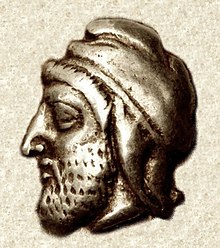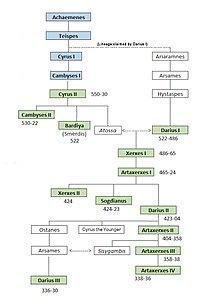| Pissuthnes | |
|---|---|
| Πισσούθνης | |
 Anonymous portrait of a Satrap of Asia Minor, around the time of Pissuthnes. From a coin of Ionia, Phokaia, circa 478-387 BCE. Anonymous portrait of a Satrap of Asia Minor, around the time of Pissuthnes. From a coin of Ionia, Phokaia, circa 478-387 BCE. | |
| Satrap of Lydia | |
| In office 440 – 415 BCE | |
| Preceded by | Artaphernes |
| Succeeded by | Tissaphernes |
| Personal details | |
| Born | 5th century BCE |
| Died | 5th century BCE Susa, Lydia, Persian empire |
| Military service | |
| Allegiance | |

Pissuthnes, also known as Pissouthnes, (Old Persian: Error: {{Transliteration}}: transliteration text not Latin script (pos 10: θ) (help)]]; Ancient Greek: Πισσούθνης Pissoúthnēs) was an Achaemenid satrap of Lydia, which included Ionia, circa 440–415 BCE. His capital was Sardis. He was the son of Hystaspes, probably himself the son of Darius I, which shows his Persian origin and his membership of the Achaemenid dynasty. He held the satrapy for over twenty years, and became extremely rich as a consequence.
He helped the Samians in the Samian Revolt against Athens, and supported various oligarchical movements against Athens along the coast of Asia Minor.

He revolted against the Persian king Darius II Nothus between 420-415 BCE. He recruited Greek mercenaries under the generalship of Lycon for his campaigns. Tissaphernes, who was sent by the King to suppress the revolt of Pissuthnes, managed to bribe Lycon, and then brought Pissuthnes to Susa where he was executed. Tissaphernes became his successor as Satrap of Lydia.
Pissuthnes had a natural son named Amorges, who continued the rebellion against the Persian king.
References
- Briant, Pierre (2002). From Cyrus to Alexander: A History of the Persian Empire. Eisenbrauns. p. 581. ISBN 9781575061207.
- Delphi Complete Works of Thucydides (Illustrated). Delphi Classics. 2013. p. 1402. ISBN 9781909496767.
- Rawlinson, George (2018). The Persian Empire. Endymion Press. p. 197. ISBN 9781531295752.
- Rawlinson, George (1885). The Seven Great Monarchies of the Ancient Eastern World: Or, The History, Geography and Antiquities of Chaldæa, Assyria, Babylon, Media, Persia, Parthia, and Sassanian Or New Persian Empire. J. W. Lovell Company. p. 507.
- The Cambridge Ancient History. Cambridge University Press. 1970. p. 143. ISBN 9780521233477.
- Briant, Pierre (2002). From Cyrus to Alexander: A History of the Persian Empire. Eisenbrauns. p. 675. ISBN 9781575061207.
- Briant, Pierre (2002). From Cyrus to Alexander: A History of the Persian Empire. Eisenbrauns. p. 578. ISBN 9781575061207.
- Rawlinson, George (2018). The Persian Empire. Endymion Press. p. 197. ISBN 9781531295752.
- The Cambridge Ancient History. Cambridge University Press. 1970. p. 464. ISBN 9780521233477.
- Delphi Complete Works of Thucydides (Illustrated). Delphi Classics. 2013. p. 2127. ISBN 9781909496767.
External links
| Rulers in the Achaemenid Empire | ||
|---|---|---|
| Family tree - Achaemenid Kingdom | ||
| Kings of Kings of the Achaemenid Empire |  | |
| Satraps of Lydia | ||
| Satraps of Hellespontine Phrygia | ||
| Satraps of Cappadocia | ||
| Greek Governors of Asia Minor cities | ||
| Dynasts of Lycia | ||
| Dynasts of Caria | ||
| Kings of Macedonia | ||
| Kings of Tyre | ||
| Kings of Sidon |
| |
| Satraps of Armenia | ||
| Satraps of Egypt | ||
| Satraps of Bactria | ||
| Satraps of Media | ||
| Satraps of Cilicia | ||
| Other known satraps | ||
| In most territories, Achaemenid rulers were succeeded by Hellenistic satraps and Hellenistic rulers from around 330 BC | ||